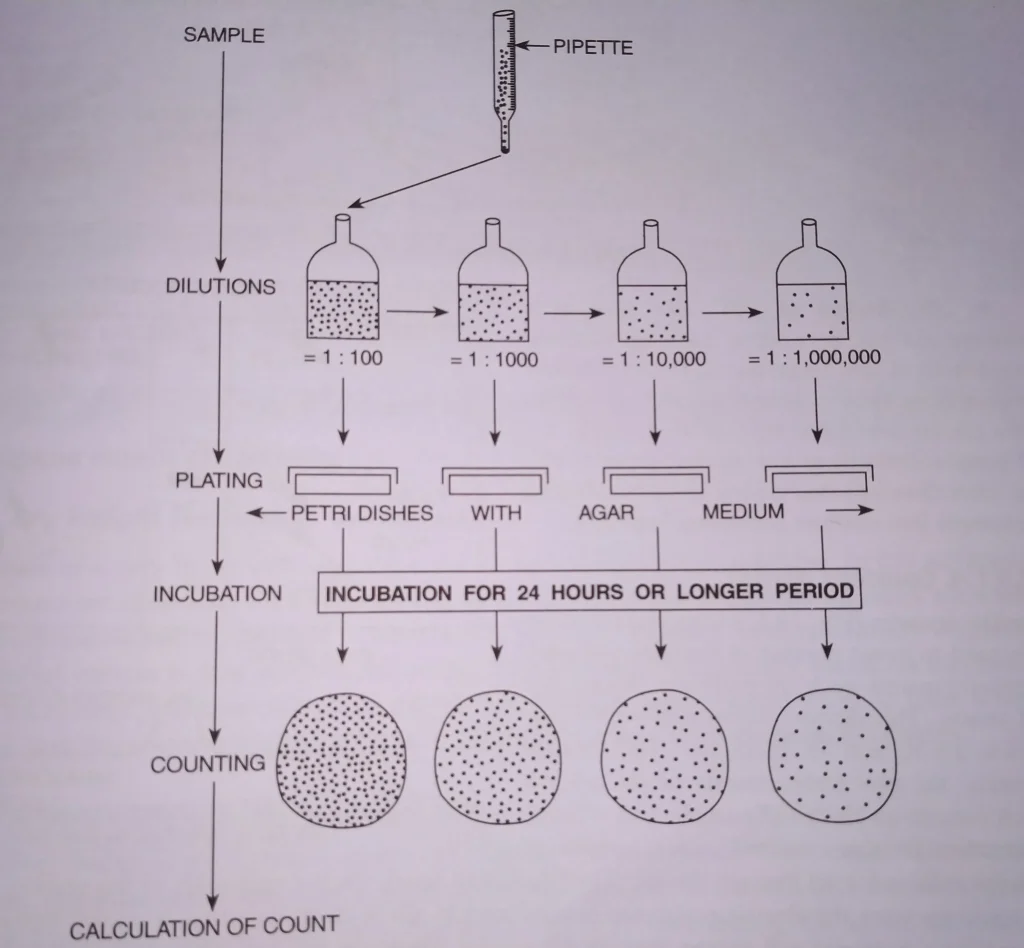A bacterial culture need not contain all living cells; there might be some dead cells as well. The culture when grown in proper medium and under standard set or growth conditions, only living cells grow and form colony. This fact is used to estimate number of living bacterial cells; the estimation of number of living bacterial cells is called viable count. Standard Plate Count (SPC) method is the most commonly used laboratory technique for viable count of bacterial cells in milk, food, water, and many other materials. Various aspects of SPC are the following.
Procedure of Standard Plate Count
To estimate the number of living bacterial cells in milk, for convenience, the sample of well mixed milk is taken into a pipette. 1 ml of milk dropped and mixed in 99 ml of sterile dilute solution (may be water or nutrient broth or saline solution) taken into a flask. This results in a dilution of 1: 100 into the flask. Other flasks each containing 99 ml of sterile dilute solution are taken and dilutions of 1: 1000, 1: 10,000, and 1,000,000 are prepared into them. Now, 1 ml of each dilution is transferred into separate Petri dishes containing pre-solidified agar medium. The Petri dishes are incubated for 24 hours or more. Each living bacterial cell in dilutions grow in respective Petri dishes reproducing itself until a visible mass of bacterial cells, a colony, develops, i.e., one bacterial cell gives rise to one colony. The original sample is subsequently diluted till the number of colonies developing on Petri dish fall in the range of 30-300 because the count is almost accurate, and the possibility of interference of one colony with that of another is minimized.

Counting of colonies
Each Petri dish is taken for counting of colonies. Colonies are usually counted by illuminating them from below (dark field illumination) so that they are easily visible, and a large magnifying lens is often used. For this purpose, various instruments such as Quebec colony counter and electronic colony counter are used. Quebec colony counter is one of the simplest colony counters used in small laboratories. In this, the Petri dish containing bacterial colonies is mounted on a platform. When the Petri dish is illuminated from beneath, the visible colonies can be counted with the help of its lens that provides X15 magnification. Electronic colony counter is highly improved device. The Petri dish is placed on its illuminated stage, the count bar is depressed, and the precise number of colonies is instantly displayed on a digital readout.
Calculation of count
The probable number of bacteria per ml in the original sample can be estimated by multiplying bacterial colony count by the reciprocal of the dilution and of the volume used.
If you are interested in knowing about Polymerase Chain Reaction steps then you can read this compact notes form article.
Limitations of Standard Plate Count
- Only bacteria that will be counted are those which can grow on the medium used and under the conditions of incubation provided.
- Each viable bacterial cell that is capable of growing under the culture conditions provided may not necessarily result in one colony. The development of one colony from one bacterial cell can only take place when the bacterial suspension is homogenous and no aggregates of cells are present in it.
However, if the bacterial cells possess the tendency to aggregate. eg. cocci in clusters (staphylococci), chains (streptococci), or pairs (diplococci), the resulting counts will be lower than the number of actual bacterial cells. For this reason the counts are often reported as colony forming units (CFU) per millilitre rather than number of bacterial cells per millilitre.
Advantages of Standard Plate Count
SPC is easy to perform and can be used to measure bacterial populations of any magnitude. It is very sensitive technique and even very small number of bacterial cells can be counted using it. Theoretically, if 1 ml sample contains as few as one bacterial cell. the latter develops one colony upon transferring the sample into medium containing Petri dish.
